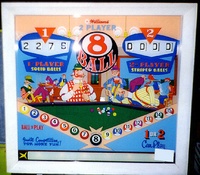

8 Ball
The 1988 book Pinball The Lure of the Silver Ball stated that a "split bank" was invented by Norm Clark for '8 Ball' and reused again on Williams' 1971 'Solids N Stripes'. However, 'Solids N Stripes' is his first game to employ the "split bank" method of ball-to-ball carry-over for multi-player games. For '8 Ball', instead of relay banks a standard step-up unit was used for each player to count the billiard balls earned by that player. A standard Player Relay alternated between players to select which of the two playfield step-up units is active for the player who is being served. In this way, the Player Relay dedicated a step-up unit for each player, allowing for each player a separate accounting of earned billiard balls to appear on both the backglass and the playfield. This is an example of playfield "memory" for multi-player EM games. On '8 Ball', the billiard balls have to be earned in numerical sequence so it made sense for this game to use for each player a sequential mechanism such as a stepper unit with reset coil. In contrast, because the billiard balls on 'Solids N Stripes' can be earned in any random order, it makes sense for that game to have relay banks which will track them in any order in which they are earned. '8 Ball' is not the only Williams 2-player EM game that had playfield "memory" using alternating step-up units. An earlier game is Williams' 1956 'Piccadilly'. A subsequent game is Williams' 1968 'Pit Stop'. Manufacturer data for 8 Ball: Quantity produced for USA/Canada: 1501* Quantity produced for export: 1749* Total quantity produced: 3250* Price to Distributor: $430.00 *These quantities may be sales estimates.




























































